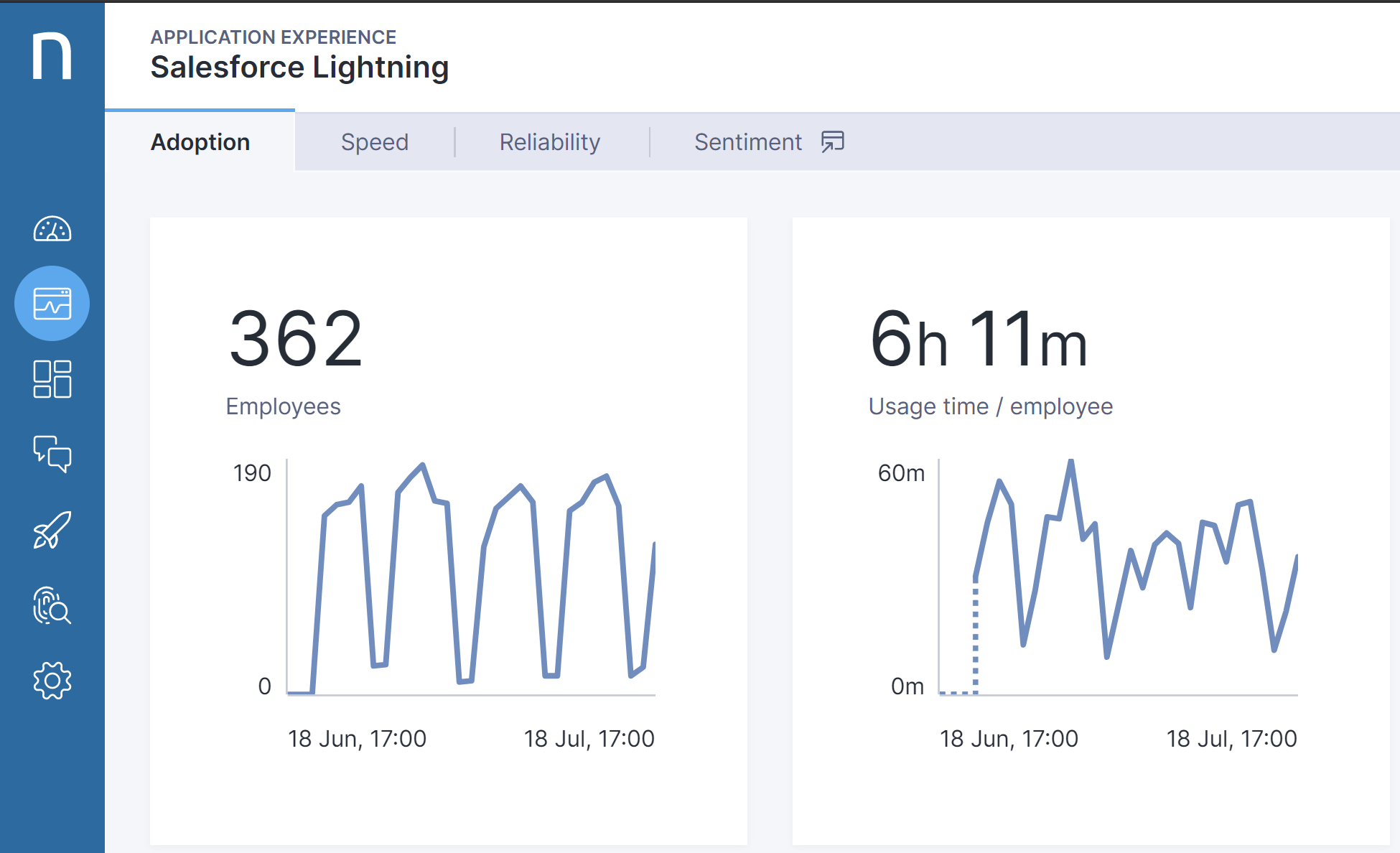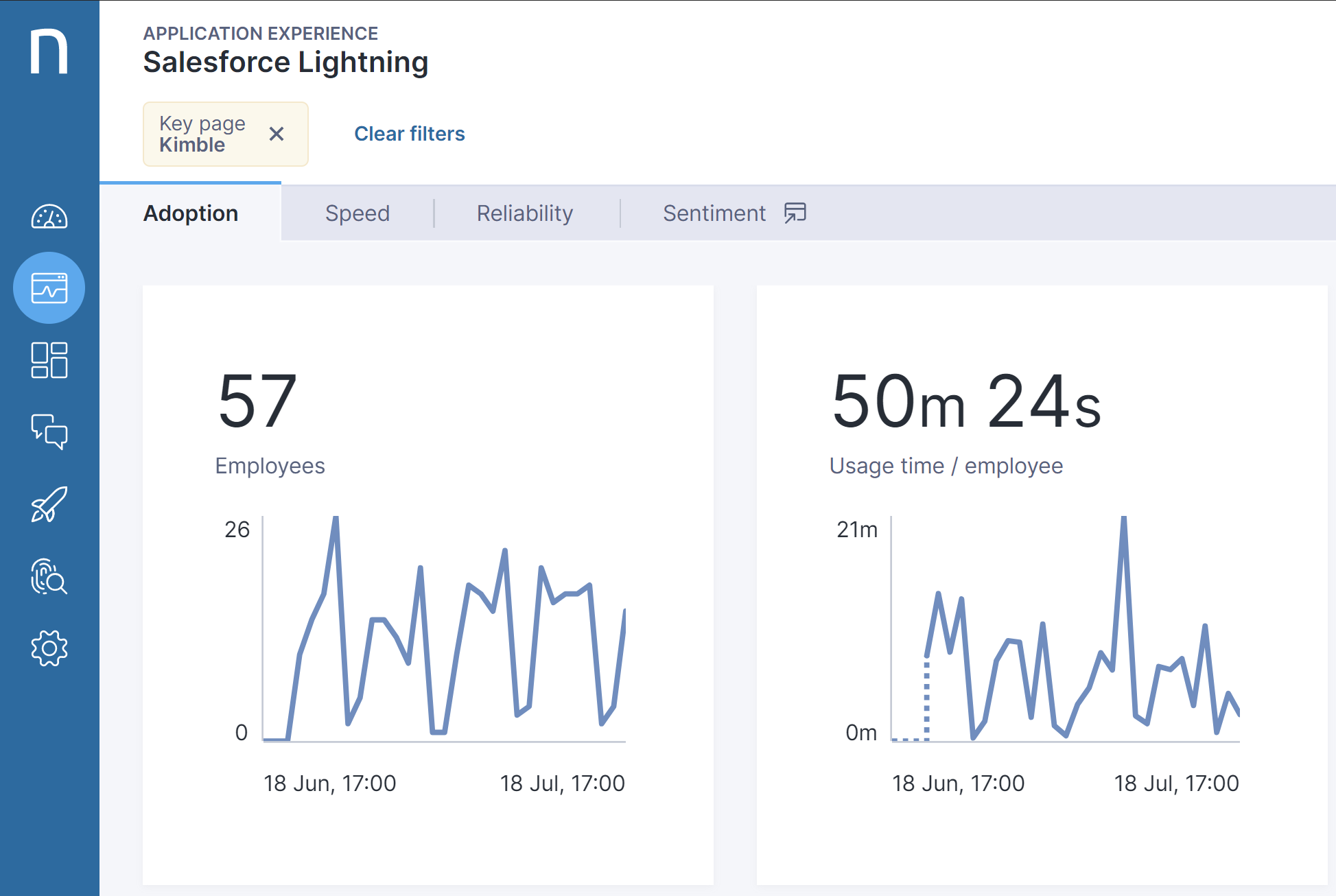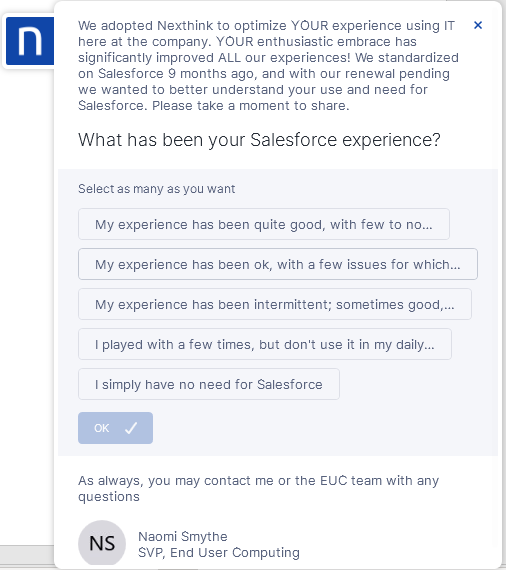I recently spoke to the IT Director and Head of End User Computing at a leading healthcare company who implemented Salesforce globally across their entire employee user base 9 months ago (before later becoming a Nexthink customer).
She told me their Salesforce licensing model was similar to others you’ll see in market: a set of base licenses and then selected add-ons based on employee roles – with some at no charge and others priced ala carte.
Her problem?
License metering. Her team was tracking their licenses and planning renewal budget based on total number of employees per allocated license, not by how many people use Salesforce or for how long they’d been using it—a common mistake many IT leaders commit.
Salesforce licenses—along with their other SaaS tools—were licensed per-user, per-month, with a yearly enterprise agreement for better discounts. IT would count the number of licenses deployed to users then manually check that against total license counts available in their purchase pool.
All of this information was painfully thrown together in a beastly, multi-colored, Excel spreadsheet, with several tabs set up for each and every web business application.
Our solution:
A few months after using Nexthink Experience, IT was able to make 3 massive data-driven wins:
1) Onboard employees with the right licenses by department and role
2) Reclaim unused licenses and share those with new employees
3) Accurately predict software need per employee and role by looking at actual usage – which wound up saving IT close to $1.8M on unnecessary Salesforce renewal fees!
Into the weeds of IT decision making…
At rollout, 2,000 employees had been given licenses – all thought to potentially have a need for Salesforce in their daily job/workflow. If you’re paying attention—that was their first mistake—basing purchase quantities on assumptions rather that hard data. Keep reading to find out just how far off that number was from reality.
The Application team also licensed additional, layered Salesforce products, such as Salesforce CPQ and Einstein Analytics, but for a subset of the 2,000 base Salesforce licenses. Adding further complexity, were additional software licenses for third party products such as Kimble (Services), and Gainsight (Customer Success).
Like many IT teams I’ve worked with, they tracked their application licenses by counting the number of licenses given to users, which they’d manually check against total licenses available in their purchase pool via that massive Excel spreadsheet. When employees were onboarded, they were given licenses based on their department/role. When offboarded, licenses would then be reclaimed and become available to be re-deployed to new employees.
These procedures made sense on the surface, but as my team soon helped them discover—their assumptions about license usage and how employees truly experienced their digital services were unknowingly costing them dearly.
Right-size licensing & boosting employee productivity
With renewal imminent, the C-suite at the company started asking the CIO to answer extremely simple questions with potentially serious financial and operational impacts:
- How many users are really using all these costly licenses and add-on features?
- What is employee sentiment while using them?
- Are our employees productively using it?
Those questions fell down the chain of command to IT’s end-user team, who of course quickly hit a wall because the information they needed wasn’t something you could retrieve in a snap… (or could you?).
It’s hard to have answers when you have no visibility…
The questions that trickled down from the C-suite opened a pandora’s box, not just concerning Salesforce, but every application being used (or not) by the company’s employees – over 300 individually licensed web applications across their 20,000+ employees. Each with potential (and currently completely unknown) issues related to non-adoption, poor employee experience, and stifled productivity, not to mention the potential for misaligned licensing costs.
They couldn’t solve these problems because they couldn’t see them, and yet the Director’s team would still be held accountable.
A costly dilemma
The IT Director told me that the best they could get from Salesforce was a high-level view into how many licenses were deployed versus how many are paid for.
That was the case across the board and, as she put it, “my teams can’t monitor and proactively manage from a worksheet with dozens of tabs and Excel formulas.”
She further explained they only had two bad options in front of them, both costly and counter-productive:
1) They could turn employees’ access off for those they thought didn’t need it (based on information gleaned from nine-month-old spreadsheets) and wait for the inevitable screams from Business Leaders, Application owners and affected employees coupled with the ensuing loss of satisfaction, productivity, and money.
2) They could default to continually (as suspected) over-provision – a costly choice and the current suspicion of senior management.
The C-suite grew more impatient, demanding clarity and answers. And, after they got a handle on Salesforce, management wanted to get their other SaaS web applications “under control” as well.
Flash forward to better days
Only 3 months into using Nexthink Experience, the EUC team had already proven to leadership that they had full circle, real-time visibility into all aspects of their employee’s digital workplace experience – their desktop devices, connectivity, configuration, desktop applications, network, backend, crashes, slowdowns… all of it.
There was one critical exception: their web applications were a complete black-box to EUC and the other teams.
Fortunately, the EUC team were a recent early adopter of Nexthink Application Experience. They quickly (and automatically with Nexthink Act remote actions) deployed the Application Experience browser extension to all employees in their Salesforce spreadsheet to get insight.
They started very simply, configuring Application Experience views into their use of base Salesforce, as well as Kimble and Gainsight – at the page and key page levels only.
Within a week, they started to get answers, but they monitored for a full month to be certain. The surprising results showed that at no point did more than 207 unique employees use Salesforce on a given day, and the monthly total was only 362 (out of 2000 licensed).

Their use of Kimble was only ever a maximum of 27 a day, or 57 across a month (out of 500)!

And Gainsight was even worse, with a maximum of 8 a day, or 26 across a month (also out of 500)!
Selecting “Employees using the application the least”… they at once received a rank-ordered table of exactly which employees were using Salesforce the least.
This data surprised them.


There were several employees that apparently had only used Salesforce for a few seconds over the last month, and over 1500 that had only used it for 10 minutes or less! What were the issues, and was this an opportunity to confirm a potential to save a lot of money – as senior management suspected?
They executed an automated Nexthink Engage sentiment campaign to those employees that same day, to learn their experience with, and need for, Salesforce. They started with base Salesforce because it was a pre-requisite for Kimble, Gainsight, etc., and they wanted to gain clarity where they could quickly have the most impact.

And the survey says…
The results surprised them and pointed to the immediate potential for significant cost savings!
While product owners and direct sales teams were consistently using Salesforce, most employees either never used it, or briefly used it once or twice, never to return. This was at complete odds to their spreadsheets based on first assumptions at the beginning of the project over 9 months ago and “kept current” since only when employees onboarded or offboarded.
They continued monitoring, running the campaign for a week to increase confidence. Usage and sentiment data were consistent over time, with 85% of the employees responding to the campaign.
The results?
The company would reclaim 1500 Salesforce licenses at their renewal in a bit more than 2 months. They planned to keep a “buffer” of a spare 154 licenses over the measured usage due to plans for future growth. This would save them well over $1.8M on their Salesforce license fees.
(Note: 1,500 Salesforce licenses x $100 per employee per month x 12 months = $1.8M).
Senior management was impressed, seeing the EUC team as visionary for their recent decision to standardize on Nexthink Experience, and excited at the additional comprehensive visibility brought by Application Experience.
Immediate next steps include:
1) Highly targeted Engage sentiment campaigns to dig deeper into the detailed usage of Salesforce focused on CPQ, Einstein, Kimble, and Gainsight to more fully optimize costs.
2) All new applications to be monitored and managed by Nexthink Application Experience.
Proactive cooperation of Application owners and EUC team from day-0, so all new applications, features and add-ons are life-cycle managed, including Engage sentiment campaigns.
3) For the most business-critical applications, EUC and Application teams will configure Nexthink Application Experience management of employee experience of performance, reliability, and usage for business-critical transactions within these web applications, to optimize employee experience, workflow, and productivity, as well as uncover hidden application usage training requirements.
4) Optimize the total Employee Experience Retrofit monitoring of the company’s 300+ web applications (in priority order, most expensive first), using Nexthink Experience Optimization to proactively put the total employee experience at the top level of their management process.
As the head of EUC put it:
“At our C-level, our leaders constantly manage and report on critical business metrics. Sales has top-of funnel, and almost real-time revenue forecasts. Finance has profitability. Lines of business have market penetration and revenue. All we ever had was ‘we reduced the number of technology service incidents by 7%’, metrics like that. Now, with Nexthink Experience and Application Experience, coupled with the scores and proactive management I get with Nexthink Experience Optimization, EUC has a real-time ‘balanced scorecard’ of employee experience and productivity, which is giving me a seat at the big table!”
This is one quick example of how Nexthink Experience coupled with Application Experience rapidly knocks down barriers to completely understanding employee use of, and experience with web-based business applications to drive significant business value.
If you’re interested in learning more, please schedule a 30 minute demo a Nexthink.
Related posts:
- Uncover How Your Employees Experience Their SaaS Applications in Real-Time
- 5 Sustainable IT Practices for Your SaaS Applications
- 3 Big Reasons to Upgrade to Nexthink Experience